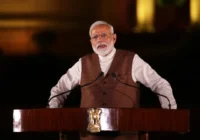For India to maintain its position as a global leader, more concerted efforts at local and federal levels will be necessary to bring women to parity with men.
In the past decade, India has stepped into its new role as a rising economic monolith, providing a counterbalance to China and recasting a new global landscape. Yet underlying its spectacular growth is a current of discontentment. India’s growth has been expansive, but it hasn’t been equitable or inclusive. India must now turn to its greatest untapped resource — women — if it wants to become a global superpower.
Women in India represent nearly 10% of the entire world population, yet discrimination against them is widespread. As India’s GDP has grown steadily around 6%, female labor force participation has plummeted from nearly 37% in 2005 to 27% in 2013. During this period, approximately 20 million women dropped out of the workforce, equivalent the entire population of Sri Lanka.
At the same time, violence against women and girls in India has drastically increased. Reuters finds that today India is the world’s most dangerous country for women, well ahead of Syria, Somalia, Afghanistan and other conflict-afflicted countries. Meanwhile, the World Economic Forum’s gender Gap Report ranked India 108 out of 149 countries in 2018, identifying it as one of the worst countries on gender parity based on factors including health and survival, education and economic opportunity.
India has taken some steps to support women’s economic empowerment under Prime Minister Narendra Modi, but it hasn’t done nearly enough. In 2017, India co-hosted the first Global Entrepreneurship Summit with the US government in Hyderabad to showcase its support for women in business. More than 1,5000 participants from 150 countries attended the event. Yet behind the façade of diplomatic handshakes and carefully crafted remarks about the value of female entrepreneurship, it was clear that India would only commit at a surface level, and it soon returned to the status quo.
To enhance the economic status of women and girls in India, the country’s next prime minister should focus on educational access that includes technical and vocational training. Reforms should target the country’s often-neglected rural areas, where 70% of the population lives. India must simultaneously address challenges around its urban-rural divide. The country’s rapid urbanization has created more jobs, but not enough women have been able to access urban areas due to the lack of safe transport and public safety in the country.
Finally, India must also mobilize emerging technology to invest in women’s financial inclusion. In particular, blockchain technology and the country’s new biometric ID system, Aadhar, may help to provide women with access to credit. Digital IDs also have endless social benefits. On the most basic level, they help women to gain access to land rights and take out loans, which are critical for women opening small businesses.
Yet their reach extends even further: Elderly women will be able to have pensions credited to their accounts, girls will be able receive scholarships to cover their education, and federal government benefits will be sent digitally so that women and girls do not have to travel to unsafe areas to collect money. With the help of these new technologies, financial inclusion of women in India has already increased by 24% in the past three years as over 35 million poor women have begun to open and operate their own bank accounts for the very first time.
For India to maintain its position as a global leader, more concerted efforts at local and federal levels will be necessary to bring women to parity with men. India’s current situation is a waste of human capital, a liability to its reputation, and will ultimately inhibit the country’s ability to continue inclusive and sustainable development in the next two decades.
The World Bank predicts that if reforms were made to engage half of India’s women in the workforce, the country would boost growth by 1.5 percentage points, to 9% per year, catapulting it well above China’s growth rates at the highest point. In the long run, women’s economic empowerment will also help to reduce poverty across the board, as studies show that women tend to invest more heavily in children and their communities than men.
An attitudinal shift is essential for women to be considered as equals within their homes, careers and in broader society, but even more so political will is needed at the highest levels of Indian politics where leaders have the capacity to establish a new standard for gender equity. In our present era, serving as a global power requires leadership at every level. India can no longer afford to neglect its women.
The views expressed in this article are the author’s own and do not necessarily reflect Fair Observer’s editorial policy.
Support Fair Observer
We rely on your support for our independence, diversity and quality.
For more than 10 years, Fair Observer has been free, fair and independent. No billionaire owns us, no advertisers control us. We are a reader-supported nonprofit. Unlike many other publications, we keep our content free for readers regardless of where they live or whether they can afford to pay. We have no paywalls and no ads.
In the post-truth era of fake news, echo chambers and filter bubbles, we publish a plurality of perspectives from around the world. Anyone can publish with us, but everyone goes through a rigorous editorial process. So, you get fact-checked, well-reasoned content instead of noise.
We publish 2,500+ voices from 90+ countries. We also conduct education and training programs
on subjects ranging from digital media and journalism to writing and critical thinking. This
doesn’t come cheap. Servers, editors, trainers and web developers cost
money.
Please consider supporting us on a regular basis as a recurring donor or a
sustaining member.
Will you support FO’s journalism?
We rely on your support for our independence, diversity and quality.






